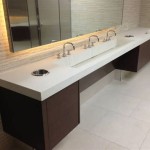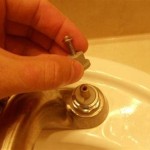Narrow Bathroom Sink And Cabinet: Optimizing Space in Compact Bathrooms
Bathrooms, especially in older homes or apartments, often present a challenge due to limited space. The selection of fixtures and furniture becomes crucial in maximizing functionality without sacrificing aesthetics. Narrow bathroom sinks and cabinets offer a practical solution for compact bathrooms, providing essential amenities within a minimal footprint. This article will delve into the advantages, considerations, and options available when choosing narrow bathroom sinks and cabinets, focusing on optimizing space and enhancing the overall design of small bathrooms.
The primary function of a bathroom sink and cabinet is to provide a washbasin and storage for toiletries and cleaning supplies. In a narrow bathroom, a standard-sized sink and cabinet combo can quickly overwhelm the space, making it feel cramped and uncomfortable. A narrow sink and cabinet combination addresses this issue by reducing the overall projection of the unit, allowing for more open floor space. This is particularly beneficial in powder rooms, guest bathrooms, and en-suite bathrooms where space is at a premium. By strategically choosing a narrow design, homeowners can create a more comfortable and visually appealing environment.
When considering a narrow bathroom sink and cabinet, it's essential to understand the available options and the factors that influence the selection process. The dimensions, style, material, and mounting type all play a significant role in determining the suitability of a particular unit for a given bathroom layout. Careful planning and consideration of these elements are crucial for achieving a functional and aesthetically pleasing result.
Key Point 1: Understanding Size and Dimensions
The defining characteristic of a narrow bathroom sink and cabinet is its reduced depth compared to standard models. Standard bathroom vanities typically range from 18 to 24 inches in depth. Narrow vanities, conversely, typically range from 12 to 18 inches in depth, and in some cases, even narrower options are available. This reduction in depth can make a significant difference in the perceived and actual space available within the bathroom. The width and height of the unit should also be carefully considered, taking into account the overall dimensions of the bathroom and the placement of other fixtures.
Before purchasing a narrow sink and cabinet, it is crucial to accurately measure the available space. Consider the location of existing plumbing, the swing of the bathroom door, and the proximity to other fixtures such as the toilet and shower. A tape measure is an indispensable tool for this process. It is also beneficial to create a scale drawing or use a bathroom design software to visualize the layout and ensure that the chosen sink and cabinet will fit comfortably without obstructing movement.
The height of the vanity is another critical factor to consider. Standard vanity heights typically range from 30 to 36 inches. However, adjustable-height vanities are also available, allowing for customization to suit the specific needs of the user. When selecting the height, consider the height of the primary user and any potential accessibility requirements.
Beyond the overall dimensions, the size and shape of the sink itself are also important. Narrow sinks are available in various shapes, including rectangular, oval, and round. The shape of the sink can influence the amount of usable space within the basin and the overall aesthetic appeal of the unit. A rectangular sink, for example, may offer more usable surface area than a round sink of the same width.
Key Point 2: Exploring Different Styles and Materials
Narrow bathroom sinks and cabinets are available in a wide range of styles to complement various bathroom designs. From modern and minimalist to traditional and ornate, there is a style to suit every taste. The style of the sink and cabinet should be consistent with the overall aesthetic of the bathroom, creating a cohesive and harmonious design.
Modern styles often feature clean lines, geometric shapes, and minimalist detailing. These vanities may be constructed from materials such as glass, stainless steel, or engineered wood with a sleek finish. Contemporary designs often incorporate floating vanities, which are mounted to the wall without touching the floor, creating a sense of openness and spaciousness. These floating vanities are particularly well-suited for narrow bathrooms as they maximize floor space.
Traditional styles typically feature more ornate detailing, such as carved moldings, raised panels, and decorative hardware. These vanities are often constructed from solid wood, such as oak, maple, or cherry, and may be finished with a stain or paint. Traditional vanities can add a touch of elegance and sophistication to a bathroom, but it's crucial to ensure that the design is not too bulky for a narrow space.
The material of the sink and cabinet is another important consideration. Sinks are typically made from materials such as vitreous china, porcelain, or stone. Vitreous china is a popular choice due to its durability, stain resistance, and affordability. Porcelain sinks offer similar benefits and are often available in a wider range of colors and styles. Stone sinks, such as marble or granite, can add a touch of luxury to a bathroom, but they require more maintenance and are typically more expensive.
Cabinets can be constructed from various materials, including solid wood, plywood, MDF (medium-density fiberboard), and particleboard. Solid wood is the most durable and long-lasting option, but it is also the most expensive. Plywood is a good alternative to solid wood, offering a balance of durability and affordability. MDF and particleboard are less expensive options, but they are also more susceptible to moisture damage. When selecting a cabinet material, consider the humidity levels in the bathroom and choose a material that is resistant to warping and cracking.
Key Point 3: Evaluating Mounting Options and Storage Solutions
The mounting option for a narrow bathroom sink and cabinet can significantly impact the overall space optimization in a small bathroom. Wall-mounted vanities, also known as floating vanities, are an excellent choice for narrow spaces as they free up floor space, creating a more open and airy feel. This design also allows for easier cleaning underneath the vanity. Pedestal sinks are another space-saving option, although they typically offer minimal storage. Freestanding vanities, while offering more storage, can take up more floor space and may not be the best choice for extremely narrow bathrooms.
Storage solutions within the cabinet are crucial for maximizing functionality in a narrow bathroom. Consider the types of items that need to be stored and choose a cabinet configuration that meets those needs. Drawers are ideal for storing smaller items, such as toiletries and makeup, while shelves are better suited for larger items, such as towels and cleaning supplies. Some vanities may also include a combination of drawers and shelves.
Within the cabinet, explore options like pull-out organizers, drawer dividers, and adjustable shelves to further optimize storage space. These accessories can help to keep items organized and easily accessible. Consider incorporating vertical storage solutions, such as tall, narrow cabinets or shelving units, to maximize space utilization in the bathroom.
Beyond the cabinet storage, consider incorporating additional storage solutions in the bathroom, such as over-the-toilet storage units, wall-mounted shelves, and decorative baskets. These additional storage options can help to keep the countertop clear and organized, creating a more functional and visually appealing space. Selecting mirrored cabinets over the sink can also provide hidden storage, maximizing space while maintaining a clean aesthetic.
Lighting is also a crucial element in a narrow bathroom. Good lighting can make a small space feel larger and more inviting. Consider incorporating multiple light sources, such as overhead lighting, vanity lighting, and accent lighting. Vanity lighting should be positioned to provide adequate illumination for tasks such as shaving and applying makeup. LED lighting is a popular choice for bathrooms due to its energy efficiency and long lifespan. Proper ventilation is also essential to prevent moisture buildup and mold growth. Ensure that the bathroom has adequate ventilation, either through a window or an exhaust fan.
Ultimately, the selection of a narrow bathroom sink and cabinet requires careful consideration of size, style, material, mounting options, and storage solutions. By thoughtfully evaluating these factors, homeowners can create a functional and aesthetically pleasing bathroom even in the most compact spaces. Prioritizing space optimization without compromising on style and functionality is key to achieving a comfortable and enjoyable bathroom experience.

Narrow Depth Bathroom Vanities Signature Hardware

Magic Home 20 In X 16 34 Freestanding Small Bathroom Vanity Cabinet Green With White Caremic Sink Top Storage Rack Cs Wf283482aad The Depot
Solid Oak Bathroom Cabinet Compact Vanity Sink Small Units

Nameeks Mini5 By Nameek S Mini Small Bathroom Vanity Floating Modern 24 Thebath

Narrow Depth Bathroom Vanities Signature Hardware

Funkol 18 In W Simplicity Style Freestanding Small Bathroom Vanity With Single Sink And Soft Closing Doors Dark Brow V Lf 66401 The Home Depot

17 9 Inch Modern Console Small Bath Vanity With Sink

Nameeks Mini13 By Nameek S Mini Small Floating Bathroom Vanity Modern Blue 24 Thebath

Maximize Space With Sink Cabinet For Small Bathrooms

24 Adelina Contemporary Small Slim Narrow White Bathroom Vanity
Related Posts







